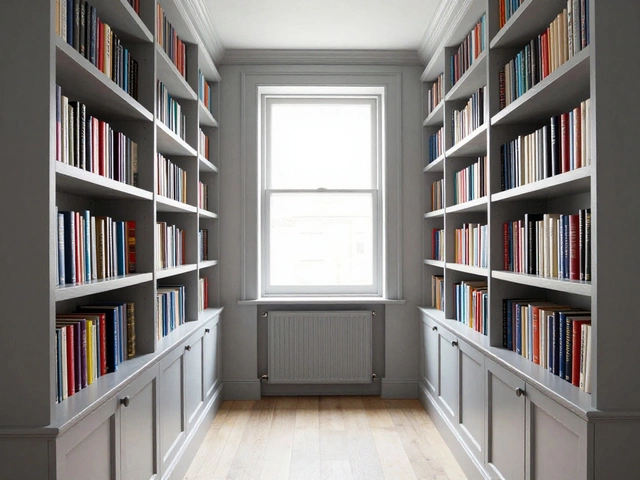In recent years, furniture trends have shifted significantly as people spend more time at home, seeking both comfort and style. The year 2024 sees an interesting mix of nostalgia, sustainability, and innovation influencing furniture choices.
Among the most coveted are modular and multifunctional pieces. These designs are perfect for those who want to make the most of their space without sacrificing style. The ability to adapt and reconfigure makes such options ideal for modern living.
Another trend that's capturing hearts is the revival of vintage and retro furniture. These charming pieces not only bring character to a space but also tell unique stories, adding a personal touch to any room.
With an increasing awareness of environmental issues, sustainable and eco-friendly furniture has carved out its space in the market. Consumers are more conscious about the impact of their purchases, valuing materials with a low carbon footprint and ethical production processes.
Finally, minimalist designs continue to appeal to those who appreciate clean lines and simplicity. This style is ideal for creating serene spaces that promote relaxation and clarity.
- Modular and Multifuntional Furniture
- Vintage and Retro Revival
- Sustainable and Eco-friendly Choices
- Minimalist and Sleek Designs
Modular and Multifuntional Furniture
The concept of modular and multifunctional furniture has revolutionized the way we design and utilize our homes. This trend is a nod to the realities of urban living, where space is often at a premium. Homeowners and renters alike are increasingly seeking smart solutions that allow them to maximize their environments without compromising on style or functionality. These ingenious pieces are more than just space savers; they bring a new level of creativity into interior design. Perhaps, most interestingly, the ability to adapt and change configurations brings a playful flexibility, turning rooms into dynamic spaces that evolve with daily needs.
One of the best examples of this is the sofa bed, which transforms from a comfortable seating area into a cozy sleeping space in seconds. But today's designs go far beyond this classic innovation. Think modular seating that can be rearranged to fit any occasion, or coffee tables with hidden storage compartments that help keep clutter at bay. Even shelving units are now designed to be adjustable or reconfigurable, accommodating various book sizes, electronics, or decorative elements. This adaptability means you can personalize your space to suit your lifestyle, whether you’re hosting friends or working from home.
The rise of multifunctional furniture also aligns with a growing interest in sustainable living. By investing in fewer pieces that serve multiple purposes, consumers can reduce their environmental footprint. This thinking is reflected in modern materials and manufacturing techniques. For example, many companies are now using recycled or sustainably sourced materials to create eco-friendly products. A significant portion of these brands pride themselves on creating durable furniture designed to last, reducing the need for frequent replacements.
Interestingly, modular designs are not just about practicality; they also embrace aesthetics. The sleek, clean lines of contemporary modular systems often embody minimalist principles, creating serene and uncluttered spaces. This blend of beauty and utility has made modular furniture a staple in today’s leading interior design projects. A popular choice among those who appreciate a combination of elegance and innovation, these pieces cater to a broad range of tastes, making them suitable for both traditional and modern decor.
An influential voice in this domain, designer Elaine Rosner once stated,
"Modular furniture was born from a need to think differently about space. It challenges traditional concepts of ownership by encouraging us to share, adapt, and renew how we live within our homes."Her perspective underscores how these innovations reflect wider societal shifts towards flexibility and sustainability. They echo the modern ethos that our homes should adapt to our ever-changing lives.

Vintage and Retro Revival
The world of home decor is seeing a significant vintage and retro revival, a trend that’s been steadily gaining traction. Nostalgia seems to be the driving force behind this resurgence, as more people are drawn to the charm of bygone eras. From mid-century modern to Art Deco, vintage furniture brings an element of character and history that contemporary pieces often lack. It’s not just about style, but also about the stories embedded in each piece, which adds a unique touch to any space.
One would wonder why old has become the new 'new.' The appeal lies in the craftsmanship and the sturdy materials that were used in past decades, which can often surpass today's mass-produced items. This trend isn't just about buying second-hand or imitation vintage. There's a significant market revival where original pieces are often restored to last another lifetime. As the saying goes, 'they don't make them like they used to,' and for many, that rings true.
Renowned interior designers like Emily Henderson have emphasized the importance of integrating these timeless furnishings.
She says, "Incorporating vintage pieces gives your home a sense of history and soul. It’s what makes a cookie-cutter house feel truly unique."The juxtaposition of mixing the old with the new isn’t just aesthetically pleasing; it's a conversation starter and a way to preserve history within your own four walls.
An interesting aspect of the vintage revival is the economic benefits. According to a survey by the National Retail Federation, vintage furniture purchases increased by 21% in 2023. This trend shows no signs of slowing, suggesting it's financially smart to invest in original pieces. They're often cheaper than buying new furniture of equal quality while retaining or even increasing their value. It's almost like investing in art, where the right piece can appreciate over time, a safe bet for those looking to mix aesthetics with assets.
Whether it’s a sleek 1960s credenza, a classic Eames chair, or a charming retro lamp, shopping vintage is an opportunity to express individuality. These pieces aren’t just furniture; they’re relics of the past that have lived through stories, only to continue creating more in new settings. The beauty of this revival is truly in its diversity, offering something for everyone while promoting an eco-conscious mindset by recycling and reusing. Vintage and retro furniture remind us that beauty and functionality do not have an expiration date.

Sustainable and Eco-friendly Choices
The demand for sustainable and eco-friendly furniture has soared as awareness about environmental conservation spreads. With climate change knocking persistently at our doors, individuals are actively seeking ways to reduce their carbon footprint, leading to a surge in eco-conscious consumer habits. Sustainable furniture is lovingly crafted from renewable resources such as bamboo, reclaimed wood, or recycled metals. These materials not only promote environmental benefits but also offer a longevity unmatched by traditional options. Each piece carries its unique grain pattern and texture, narrating a tale of nature's prowess.
The allure of such furniture lies in its intricate blend of aesthetics and ethics, a marriage made seamless through responsible design and production. Companies are now incorporating low-VOC finishes and using water-based glues to minimize the release of harmful chemicals into the environment. The advantage is not just cleaner air within our homes, but also, collectively, a healthier planet for future generations. On a closer look, a considerable degree of craftsmanship goes into creating these green wonders. Artisans take pride in their meticulous workmanship, ensuring each piece is both beautiful and sustainable, encapsulating an art form that contributes positively to the environment.
According to a report by the Global Furniture Market Association, the popularity of eco-friendly furniture has increased by nearly 30% since 2020, reflecting a significant shift in customer preferences. Interestingly, a diverse range of options is now available, from minimalist designs to exquisite bespoke pieces, broadening the consumer base. The industry is now bustling with innovations tailored to cater to both modern and rustic tastes, leaving a lasting impression in the world of home decor.
"The greatest threat to our planet is the belief that someone else will save it," says renowned explorer Robert Swan. This mindset has driven many to reconsider their purchasing habits, ensuring that their choices support sustainability."
The choice of sustainable and eco-friendly furniture extends beyond the materials. Circular economy practices, like upcycling and refurbishing old pieces, have gained traction. These practices allocate resources efficiently, minimizing waste, and cultivating a lifestyle that values sustainability. This approach not only preserves heritage pieces but also encourages the creative reuse of materials, fostering innovations born from necessity.
For those considering diving into the world of eco-friendly decor, here are a few helpful tips: research brands that emphasize transparency in their production processes, look for certifications like FSC (Forest Stewardship Council), prioritize quality over quantity, support local artisans, and consider long-term value over immediate convenience. As consumers' preferences continue to evolve, we can expect sustainable choices to remain at the forefront of furniture trends for years to come.

Minimalist and Sleek Designs
The allure of minimalist and sleek designs in the realm of furniture trends is undeniable, drawing homeowners who wish to create spaces that radiate tranquility and order. This design philosophy is rooted in the principle of 'less is more,' which encourages the removal of excess and the celebration of clean lines and essential forms. The appeal lies in its simplicity, where every piece serves a purpose without unnecessary frills.
One of the prime reasons for the popularity of minimalist furniture lies in its ability to open up a room. By reducing clutter and employing streamlined designs, spaces appear larger and more inviting. Materials like glass, metal, and light-hued wood are staples in this design approach, contributing to an airy, open feel that appeals to the modern aesthetic. Architects and interior designers often highlight how furniture with exposed legs or wall-mounted pieces visually enlarges a space by allowing more floor to be seen.
A feature that is making waves in sleek design is the integration of technology. Many minimalist pieces now come equipped with smart features like wireless charging stations or built-in lighting. This integration not only maintains the clean lines by eliminating the need for additional gadgets but also enhances the practical use of the furniture. For instance, a sleek coffee table with charging ports finds favour with those seeking a clutter-free, tech-savvy lifestyle.
Color plays a crucial role in this trend, emphasizing a neutral palette that promotes a calm and serene environment. Whites, greys, and beiges set the backdrop against which minimalist furniture shines. However, a striking pop of color is sometimes introduced through a singular piece of bold furniture or artwork to act as a focal point, adding interest without disrupting the harmony. It's all about balance, where each element in the room complements the other, contributing to a cohesive look.
Notably, versatility is a significant factor behind the demand for minimalist designs. Many items are multipurpose, offering innovative solutions for urban dwellers facing space constraints. For example, a sofa that transforms into a bed or a console table that expands to a dining table highlights how minimalist furniture is not just about aesthetics but also functionality. This adaptability suits fast-paced modern lifestyles, where the ability to easily transform spaces is a treasured convenience.
As a spokesperson from a leading design magazine once noted,
"Minimalism isn't merely decorating with less; it's about choosing what adds the most value to your life."This philosophy resonates with those who value quality over quantity, opting for investment pieces that stand the test of time both in durability and style. Minimalist designs are not a fleeting trend but rather a reflection of a mindful lifestyle choice, advocating for a deliberate and thoughtful approach to home decor.







